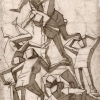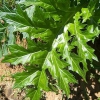Efficiently. That's how you want to carve. Fresh. That's how you want your carving to look.
Here's another attitude or habit that you should adopt, right from the start of a carving. Think of 'policing the area'.
And when you've finished, don't forget to change the lighting and have another look...

| 23 February 2021 10:52
Dan - Generally, you want to pick a sweep slightly flatter than the curve you're making, and that keeps the corners clear. Exact matches will tend to bind.
Essentially I carve any 'consistent' curve by eye. If we are talking a geometrically exact curve, I'd still be sneaking up on it.
I hope that's answering your question!

| 22 February 2021 12:50
Chris, when you turn your gouge and cut with the inside bevel to make a consistent running curve how do you avoid the corners tearing the wood?

| 30 December 2014 19:23
But enough philosophy; just get stuck into your carving and let your originality out!
Point taken Chris. Thanks Dermot

| 30 December 2014 16:32
Dermot - I think the painting analogy is a good one. As the painter paints, those strokes, the size and type of brush and how it is used, becomes the finished painting. As you carve, what carving tools you use and how you use them, leaves the both the shape and the surface finish of the carving. Every carvers chooses and handles their carving tools differently; our carvings have our 'fingerprints' all over them and that is, as much as the design, a big part of a piece' 'originality'. Sanding is a tool; you can use it to remove all the carving tool marks and that will be another sort of finish, which can be just as original. I have heard it said that I 'don't believe in sanding', as if it were a moral issue. But I see it sanding as just a choice, and it can be done well or badly. But enough philosophy; just get stuck into your carving and let your originality out!

| 27 December 2014 19:07
Chris thanks for posting your comments. Would you agree then, that there is a tool for every stroke, a use for every technique. Where sanding is the technique, care has to be taken not to destroy the carvings originality. When used with care, practice and experience sanding can add to the originality.

| 27 December 2014 15:44
Dermot - It's not just that clean cutting eliminates the need to sand, which it almost always does (by not tearing the wood fibres), but you can do soooo much with carving tools that with sandpaper. Rightly it's been said that you can compare the cuts from the tools to those left by the strokes from a paintbrush. There IS a place for sanding, no doubt about it, but have you noticed how sanded carvings tend to look similar? One of the hazards of sanding is to make all parts look the same.

| 27 December 2014 09:57
Chris
I didn't intend a sanding question here as you answered this question for me before.
I can't find that original question but realise now that you answer may of the same questions
in the course of many of the tutorial videos in your gifted way.
A Bookmark For Reference: Textures
http://www.woodcarvingworkshops.tv/videos/techniques/surfaces-x3/3-smoothest

| 27 December 2014 04:28
Chris, This explanation compliments a question I asked earlier about sanding to finish.
If the practice of "Clean Cutting" is optimised, then I assume the need for sanding is ideally eliminated ?

| 05 December 2013 16:38
I have learned more in the 2 days since I joined, than in all the books I have read (even yours chris) thank you so much. I haven't been able to find any local instruction or even carving club where I live in canada. (West coast) so these videos are all the more valuable.
I am very novice at carving, but I have a passion for it. My main issue is my workshop is my balcony ( 3rd floor condo) and now that it's getting cold, I'm carving in ski pants, lol. Wish me luck on finding a good place to work.

| 07 October 2012 16:09
Extremely useful, Chris, especially on the cusp of my starting a big project.

| 10 July 2012 22:05
Chris, Good Sir,
I have been pretty impressed with what you have been doing here with your series. But, this little 5-parter really takes the cake! Short, sweet and to the point. (And more stuff to remember and practice..............).
Valuable info that we all need to use, I believe.
Thank you for your insight. You are a good scout.
sw